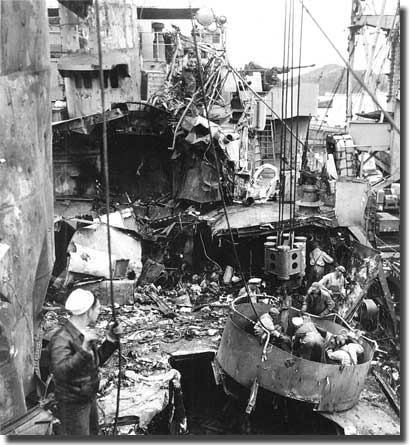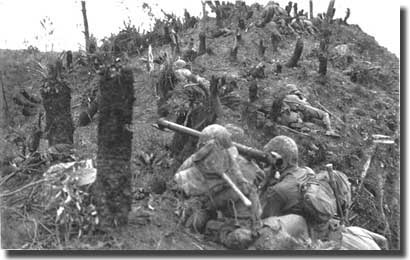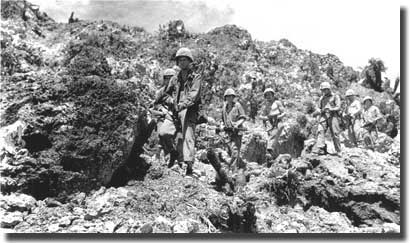|
The Battle for Okinawa. Invaded 1st. of April 1945
Introduction.
The task force off Okinawa under Kamikaze attack The enormous scale of the logistics at Okinawa. The US Fleet lost 763 aircraft, the Navy had just on 5,000 sailors killed, the Army close to 8,000 dead.
US ship badly damaged by a Kamikaze attack, off Okinawa The Japanese and Okinawan conscripts, something of the order of 107,000 dead, plus 100,000 civilian civilians slain, the mind boggles at the scale of death and destruction, all in the space of only 62 days started from the 1st. of April 1945.
Admiral Raymond A. Spruance. USN. April Fool's Day 1945.
Yet another Hill to conquer on Okinawa The battle to clean out the dug in Japanese forces started on the 6th. of April, and it took until the 21st. of June for US troops to win that fight.
The rugged terrain in the south of Okinawa The Kamikaze Campaign. The use of suicide aircraft to attack the bombarding and escort Naval ships during a seaward invasion had its inception at Letye in October of 1944, with the Australian heavy cruiser HMAS Australia their first victim. At the Lingayen Gulf landings the following January, the Fleet was to suffer many of these vicious attacks over several weeks, I was to witness many of these episodes in HMAS Shropshire, indeed a very frightening experience, very sapping of morale, it became a matter of shooting down the diving Kamikaze or collect it on board, and we despatched some 15 Japanese aircraft to fortunately remain immune from having any aircraft as unwelcome guests inboard. I can still recall the sheer terror of seeing a Japanese aircraft diving out of the sun at the bridge of Shropshire when I was her Officer of the Watch, and thinking my time had come. By the time this campaign had run its course, 1,485 Kamikaze flights out of Kyushu had attacked the US Fleet, sinking 30 ships and damaging 164 others.
Pacific Map showing Okinawa relative to Japanese mainland Japanese Battleship Yamato sent to Okinawa.
The mighty 72,000 ton Japanese Battleship Yamato Vice Admiral Marc Mitcher in his carrier Task Force at 1000 ( 10AM ) on the 7th. of June launched air strikes, and planes from USS Bennington claimed the first hits upon Yamato. Aircraft from USS San Jacinto with both bombs and torpedoes accounted for the Japanese destroyer Hamakaze, the light cruiser Yahagi, stopped dead in the water by bombs. Over the next two hours, the Japanese naval force was under constant attack, Yamato taking 12 bombs and seven torpedoes, and this was all too much, she blew up and sank. Three destroyers were too badly damaged to save and were all scuttled, the remaining four could not return to Japan. From the crew of 2,747 in Yamato, only 23 officers and 246 sailors survived, The cruiser Yahagi had 446 killed, Asashimo lost 330, and the remaining destroyers another 391 men. It was a total decimation of these Japanese naval ships, the US losses light by contrast, 12 men and 10 aircraft. Japan was not to fight at sea again in WW2.
US Major General Lemeul C. Shepherd The Big E collects a Kamikaze. Two major events during the Okinawa struggle. Conclusion.
A Marine knee deep in water prepares for a shave on Okinawa
|









